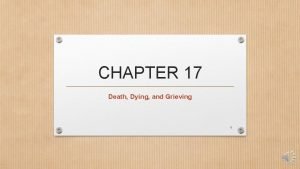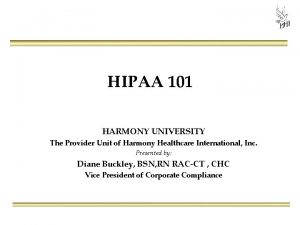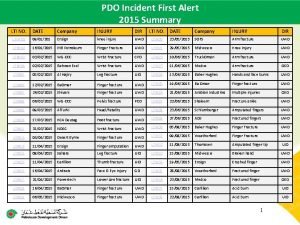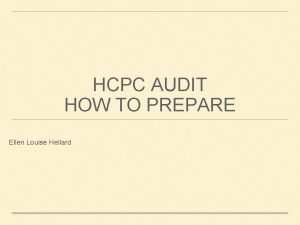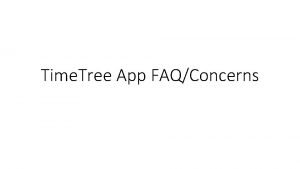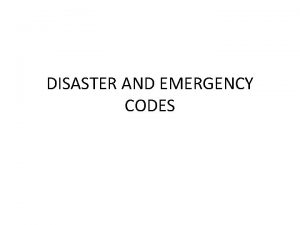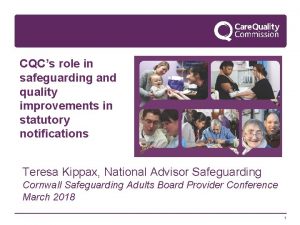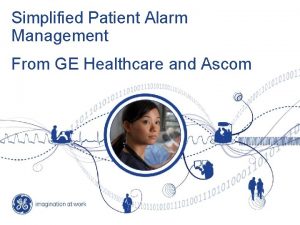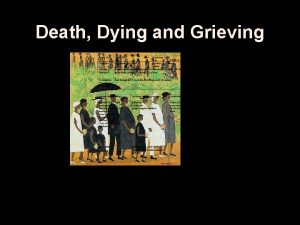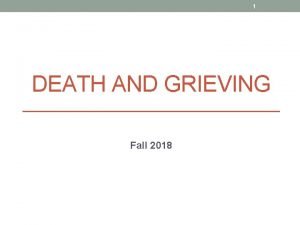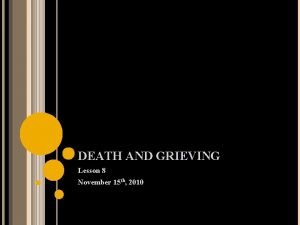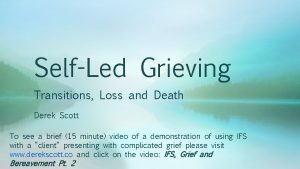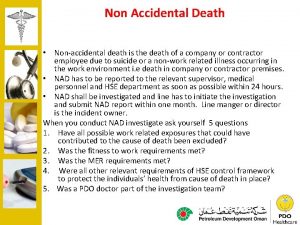GRIEVING A Tool to Improve Death Notification Copyright











































- Slides: 43

GRIEV_ING A Tool to Improve Death Notification

Copyright 2005 Cherri Hobgood, MD Associate Dean Curriculum and Educational Development Department of Emergency Medicine University of North Carolina

GRIEV_ING Objectives Learners will be able to: n Communicate using empathic skills n Organize death notification using the GRIEV_ING mnemonic n Perform an effective death notification using “GRIEV_ING”

US Deaths n Common occurrence ~ 1 Million in-hospital deaths/yr u In 2002 there were > 272, 000 ED deaths u n High Risk Significant source of family dissatisfaction u Management of the death a major determinant in malpractice litigation u

Why do we care? n All of us will care for dying patients & their families n At the end of life there is no second chance to get it right

Ideal World n Ongoing Relationship with the patient & family n Death expected with time to Emotionally Prepare n Physician has Education and Expertise in the delivery of death notification

The Intern’s World n Often no significant relationship with the patient or family n Sudden and unexpected death n Death after an emotionally exhausting failed resuscitation n Little education to prepare us to deliver this devastating news

Our World n Variables are often out of our control n Create significant stress for the MDs Emotionally draining u Dealing with Death a major cause of MD and staff disillusionment u

Their World n Stressful for family members Limited psychological preparation u Don’t know you u Have little or no contact with you afterwards u Increased rate of pathologic grief reactions t Intense grief t Prolonged mourning t Increased morbidity and mortality u

See one, Do one, Teach one. Should not apply here

Empathic Communication Empathic Characterized by or based on empathy Empathy 1. 2. Projection of a subjective state onto an object Capacity for participation in another's feelings or ideas Webster’s New Collegiate Dictionary

Empathic Communication 2 Components n Cognitive t Accurate understanding of the patient’s feelings n Behavioral t Effective communication of that understanding to the patient

Empathic Communication n Empathic u Directly expressed emotion by a patient n Empathic u Response Expressed recognition of the patient’s emotion n Empathic u Opportunity Terminator Directing the patient away from the

Empathy Identify how emotions are expressed Goal Understand our response to these expressions of emotion Recognizing and Acknowledging a Patient’s Emotion Outcome

Identify how emotions Understanding are expressed emotional expression Empathy Therapeutic Dialogue Understanding our responses to emotional expression Recognizing and Acknowledging a Patient’s Emotion

Emotional Expression n Crying n Anger n Numb, just blank n Incomprehension n Blame n Denial n Guilt n Antagonism n Hostility n Complete collapse n Hysteria n Wailing n Fear n Prayer

The Range of Emotional Responses is Wide so Expect Anything and Everything

Physician Responses n Withdrawn n Clinical n Distant n Fear n Sorrow n Antagonism n Hostility n Understanding n Empathy n Concern n Curt n Unflappable n Brave n Indifferent

How would you act if…. . n Your next door neighbor came over to tell you he had cancer? Pull up a chair and sit down u Listen u Express our sympathy and concern u Offer to help in any way we could u

Why should we act differently at work ? Misconceptions of the Professional Role Know what to do & say in every situation u Consistently unflappable and brave u Basic human resources and vocabulary unavailable u Unable to express human sympathy u

“I’m sorry” n Two types Sympathy u Apology & acceptance of responsibility u n Use phrases that express Your feelings t “ I am sorry for your loss” u Your acknowledgement of their feelings u

Listen

3 Rules of Listening 1. 2. 3. Assume an attentive posture Let people speak Then show them you heard

1. Assume an attentive posture n Introduce yourself n Shake hands n Sit down at matching eye levels n Lean forward, hands on the knees

2. Let people speak n Factoid u Average time patient is allowed to speak uninterrupted by a physician is 18 sec. n Use open questions and verbal cues to encourage their expression n Tolerate brief periods of silence

3. Then show them you heard n Repetition u Use one or two of their key words n Reiteration u Paraphrase what they have said n Reflection u Interpret & Listen for the hidden ? n Respond

Small Group Session I

What is “GRIEV_ING” n Tool to assist you An information and organizational prompt u Allows you to insure accurate and complete information transfer u Frees you to attend to the empathic portions of the communication u

n. G n. R n. I n. E n. V n_ n. I n. N n. G gather resources identify educate verify space inquire nuts and bolts give

GRIEV_ING G-Gather n The family or survivors Insure that all members are present u Offer to call others or wait if other family members will be arriving soon u

GRIEV_ING R-Resources n Call for support resources available to assist the family with their grief hospital chaplain services u family minister u family u friends u interpreter u

GRIEV_ING I-Identify n yourself and your role n the deceased patient by name n the family’s state of knowledge about the events n that you are bringing BAD NEWS u Fire the Warning Shot

GRIEV_ING E-Educate n The family Start from where they ended their story u If possible, use their terms u Avoid Jargon u Use slow and steady steps u If needed, fire another warning shot u Check their comprehension u

GRIEV_ING V-Verify n Their family member has died n Be clear! Do not use euphemisms “Passed away” u “No longer with us” u n Use the words “dead” or “died”

GRIEV_ING _Space n Give the family personal space n Emotional moment n Registration of information n Tolerate silence n Touching is ok n Give them permission to cry

GRIEV_ING I-Inquire n Ask if there any questions n Answer them all n Assess understanding Elicit summary statements from them u Listen for the hidden question u

GRIEV_ING N-Nuts and Bolts n Inquire about organ donation n Funeral services n Personal belongings n Offer the family the opportunity to view the body

GRIEV_ING G-Give n Give them your card & contact information n Offer to answer any questions that may arise later n Always return or take their call

Policies n Hospital specific n Know your hospital’s policies for Reporting deaths to the ME u Discussing organ donation with family u Calling your state’s organ procurement association u

n. G n. R n. I n. E n. V n_ n. I n. N n. G gather resources identify educate verify space inquire nuts and bolts give

“ Life is short, the art long, experience treacherous, judgment difficult” Hippocrates

Small Group Session II

Small Group Session II Structured Role Play n Three cases n Everyone will play each role n MD u Family member u Observer u n Feedback given to MD in every cycle Be accurate and specific u Scoring guides provided u
 One beneficial aspect of grieving is that it
One beneficial aspect of grieving is that it Anxiety goals nursing
Anxiety goals nursing Forensic mortician
Forensic mortician Netconf browser
Netconf browser Hipaa breach notification decision tree
Hipaa breach notification decision tree Microsoft azure notification hubs dashboard
Microsoft azure notification hubs dashboard Notification sequence diagram
Notification sequence diagram Diss jvs
Diss jvs Fnb notification settings
Fnb notification settings Casualty assistance officer army
Casualty assistance officer army Altiris notification server
Altiris notification server Supplier change notification process
Supplier change notification process Wap notification
Wap notification Pdo last lti 2022
Pdo last lti 2022 Head smart
Head smart Gst notification on solar power generating system
Gst notification on solar power generating system Bpfk product registration
Bpfk product registration Sap business one intercompany integration solution
Sap business one intercompany integration solution Push notification app inventor
Push notification app inventor Hcpc audit notification
Hcpc audit notification Browser push notifications for bfsi industry
Browser push notifications for bfsi industry Push notification firebase
Push notification firebase Time tree app
Time tree app Softweb plus
Softweb plus Win-911 alarm notification
Win-911 alarm notification Eagles award edusave
Eagles award edusave Usc kuali
Usc kuali Fire notification.mchs
Fire notification.mchs Eu cosmetic product notification portal (cpnp)
Eu cosmetic product notification portal (cpnp) Graduation notification
Graduation notification Oracle fan
Oracle fan Pendaftaran cpns 2018
Pendaftaran cpns 2018 Eccp.poste.dz notification sms inscription
Eccp.poste.dz notification sms inscription Netcore
Netcore Notification target status unreachable
Notification target status unreachable Statewide automated victim information notification
Statewide automated victim information notification Notification of action taken
Notification of action taken Registration_ids
Registration_ids Atci service notification
Atci service notification Cqc notifications safeguarding
Cqc notifications safeguarding Audit notification
Audit notification Cm notification
Cm notification Ascom unite assign
Ascom unite assign Resource manager in android framework
Resource manager in android framework
